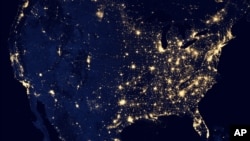The electric grid in the United States remains largely unprotected, according to a longtime adviser to Congress on national security issues.
Peter Vincent Pry told VOA he believes North Korea is ready to attempt a strike on the U.S. electric grid using an Electromagnetic Pulse (EMP). Pry said North Korea practiced an EMP strike against the U.S. last year when it orbited a satellite at the optimal altitude and trajectory to carry out such an attack.
Pry is in the northern city of Minneapolis to brief the National Council of State Legislatures this week on the EMP threat. He told VOA that three U.S. states - Arizona, Maine and Virginia - have passed legislation trying to guard against a lengthy power outage following an EMP.
Pry was a member of the former Commission to Assess the Threat to the United States from Electromagnetic Pulse Attack (2001-2008). He also is executive director of the Task Force on National and Homeland Security, a congressional advisory board dedicated to achieving protection of the United States from electromagnetic pulse and other threats.
An electromagnetic pulse (or disturbance) is a short burst of electromagnetic energy that can be natural or man-made. EMP interference generated by lightning, for example, can damage electronic equipment. At very high energy levels, an EMP can damage physical objects such as trees, buildings and aircraft.
Pry said the North Korean test last year took place over the South Pole, which he called a strategic move.
“We are blind from the south. We don’t have the Ballistic Missile Early Warning System or interceptors to protect us from the south,” said Pry.
The congressional analyst said this was done after North Korea’s third illegal nuclear test in February 2013 and after the country's leader, Kim Jong Un, threatened to strike the United States and its allies with a nuclear missile.
Rep. Yvette Clarke (D-N.Y.) said, “I cannot speak to the motives of the North Korean satellite experiment, but... we need to move with all deliberate speed to shore up our infrastructure.”
A couple months later, a North Korean freighter, the Chong Chon Gang, was caught attempting to move through the Panama Canal with a cargo of nuclear capable missiles on their launchers. They were hidden under thousands of bags of sugar.
This was no mistake on the part of the North Koreans, Pry told VOA. He said he believes Pyongyang was testing the United States to find out if it could traffic nuclear weapons through the Gulf of Mexico and the Panama Canal without detection. He said had the North Koreans gone the long way around South America, the U.S. never would have known what North Korea was shipping.
He said it was just by chance they were caught because no one was looking for nuclear missiles.
“We inspected the freighter not because anyone thought there were nuclear capable missiles onboard, but because this freighter is notorious for doing trade with drug cartels and terrorists, and so we were looking for illicit drugs that the freighter might be smuggling, and they found the nuclear capable missiles," said Pry.
Clarke, who is the ranking member on the Homeland Security Subcommittee on Emerging Threats, Cybersecurity, Science and Technology, said “again, I cannot say whether it is a deliberate attempt by the North Koreans to test out or test run the capabilities of approaching the U.S." with nuclear capable missiles, but “they are looking for ways to approach the United States, and I am sure it is not for the sake of friendly trade, but to do our nation harm.”
Clarke, together with Rep. Trent Franks (R-A.Z.), tried to address the EMP threat in June 2013 when they introduced the Shield Act, which has stalled in the House Energy and Commerce Committee.
According to Pry, near the end of the Cold War, the Russians developed the technology for a super EMP. This is a class of nuclear weapon with a special design to produce a particularly powerful EMP field. He says that in 2004 a delegation of Russian generals, including two of their top EMP experts, met with the EMP commission.
“They told us proactively, ‘we have bad news. We developed this super EMP weapon, and during the post-Cold War brain drain, some of our scientists went to North Korea,'" he said.
At the time, Pry said, the Russian generals thought that within a few years, North Korea could develop a super EMP weapon.





